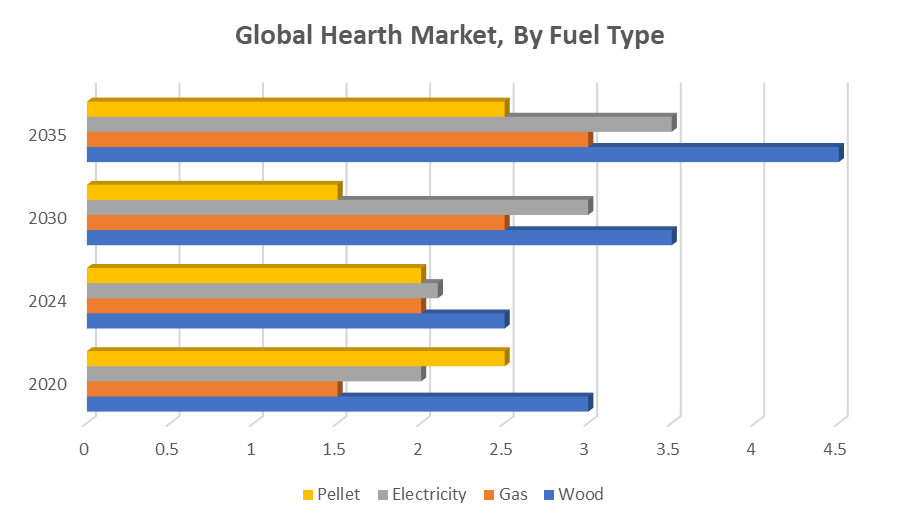Global Hearth Market Insights Forecasts to 2035
- The Global Hearth Market Size Was Estimated at USD 20.79 billion in 2024
- The Market Size is Expected to Grow at a CAGR of around 4.63% from 2025 to 2035
- The Worldwide Hearth Market Size is Expected to Reach USD 34.19 billion by 2035
- Asia Pacific is expected to grow the fastest during the forecast period.

Hearth Market
The global hearth market comprises heating appliances like fireplaces, stoves, and inserts designed for residential and commercial use. These products serve both functional and decorative purposes, providing warmth while enhancing interior aesthetics. They operate using various fuel sources such as wood, gas, electricity, and pellets, catering to different consumer preferences and environmental considerations. Valued at approximately USD 20.84 billion in 2024, the market is projected to grow steadily over the coming years. Technological advancements have led to the development of more efficient and user-friendly hearth products, including those with smart features for better control and convenience. The market also reflects a growing interest in sustainable and energy-efficient heating solutions. Overall, the hearth market plays an important role in modern heating solutions by combining traditional warmth with contemporary design and innovation, meeting the evolving demands of consumers seeking both comfort and style in their living spaces.
Attractive Opportunities in the Hearth Market
- Rising urbanization and increasing disposable incomes in emerging economies (such as China, India, and Southeast Asia) are creating new demand for home heating and décor products, offering significant growth potential.
- Developing hearth products that use renewable fuels (like pellets) or incorporate recyclable components aligns with global environmental initiatives, appealing to eco-conscious consumers.
- IoT-enabled hearth appliances with remote monitoring and energy management features provide enhanced user convenience and product differentiation in a competitive market.
- Creating customized, aesthetically appealing hearth solutions through partnerships allows manufacturers to target niche markets and meet growing consumer demand for stylish home interiors.
Global Hearth Market Dynamics
DRIVER: Rising trend of home renovation and remodeling projects
The global hearth market is driven by several key factors that fuel its growth. Increasing consumer preference for energy-efficient and eco-friendly heating solutions is a major contributor, as more people seek to reduce their carbon footprint while maintaining comfort. Additionally, the rising trend of home renovation and remodeling projects boosts demand for stylish and functional hearth products that enhance interior aesthetics. Advances in technology, such as smart home integration and improved appliance efficiency, also play a significant role by offering users greater convenience and control. Moreover, growing awareness of alternative fuel sources, like pellets and electricity, supports market expansion by providing versatile heating options. Seasonal demand in colder climates further sustains sales, as consumers prioritize reliable heating systems during winter months. Together, these driving factors create a dynamic market environment, encouraging manufacturers to innovate and offer diverse, sustainable, and attractive hearth products to meet evolving consumer needs.
RESTRAINT: High installation and maintenance costs are significant barriers
High installation and maintenance costs are significant barriers, as the expenses associated with acquiring equipment, hiring skilled installers, and ensuring compliance with regulations can deter potential buyers. Additionally, stringent regulatory requirements, including safety standards and environmental regulations, necessitate extensive testing, certification, and investment in sustainable practices, which can be time-consuming and costly for manufacturers. Another challenge is the competition from alternative heating solutions such as HVAC systems, heat pumps, and radiant floor heating, which offer convenience, energy efficiency, and versatility, potentially reducing the demand for traditional hearth products. Moreover, environmental concerns related to the production and disposal of hearth products, especially those using wood as fuel, pose challenges, as these products can generate waste and emissions, leading to increased regulatory scrutiny and a growing demand for sustainable alternatives. These factors collectively create a complex landscape for the hearth market, requiring manufacturers to navigate economic, regulatory, and environmental challenges to sustain growth.
OPPORTUNITY: Expanding into emerging markets where rising urbanization and increasing disposable
One significant opportunity lies in expanding into emerging markets where rising urbanization and increasing disposable incomes are creating new demand for home heating and décor products. Additionally, there is potential for innovation in eco-friendly and sustainable materials, such as developing hearth products that use renewable fuels or incorporate recyclable components, aligning with global environmental initiatives. The integration of advanced smart technologies, including IoT-enabled systems for remote monitoring and energy management, offers avenues for product differentiation and enhanced user experience. Collaborations with architects and interior designers also provide opportunities to create customized, aesthetically appealing hearth solutions that cater to niche markets. Furthermore, the refurbishment and replacement market represents a steady source of revenue, as aging hearth appliances require upgrading to meet modern efficiency and safety standards. These opportunities collectively pave the way for market expansion and innovation in the hearth industry.
CHALLENGES: Fluctuating cost and availability of raw materials
One such challenge is the fluctuating cost and availability of raw materials, which can affect production schedules and profit margins. Supply chain disruptions, especially in global logistics, can delay product deliveries and increase costs, creating uncertainty for manufacturers and consumers alike. Another challenge is the shifting consumer preferences toward minimalist and multifunctional home designs, which may reduce demand for traditional hearth installations. Moreover, a lack of consumer awareness about the benefits and maintenance requirements of modern hearth products can hinder adoption. Market fragmentation with numerous small and regional players also makes it difficult for companies to achieve economies of scale or consistent quality standards. Lastly, increasing competition from emerging heating technologies, such as renewable energy-based systems, demands continuous innovation, which can be resource-intensive. These challenges require strategic planning and adaptation to sustain growth in a competitive environment.
Global Hearth Market Ecosystem Analysis
The global hearth market ecosystem includes manufacturers, suppliers, distributors, retailers, end-users, and regulatory bodies. Manufacturers produce fireplaces, stoves, and inserts using various fuels like wood, gas, and electricity. Suppliers provide raw materials and components, while distributors and retailers ensure product availability to consumers. End-users drive demand based on climate and preferences. Regulatory agencies set safety and environmental standards, influencing product design. Technology providers support innovation with smart features and energy efficiency, creating a dynamic, interconnected ecosystem that fosters market growth and adaptation.
Based on the product, the fireplace segment accounted for a major revenue share and is expected to grow at a substantial CAGR during the forecast period

Fireplaces remain popular due to their combination of heating functionality and aesthetic appeal, making them a preferred choice for both residential and commercial spaces. Continuous innovations, including the integration of energy-efficient technologies and modern designs, are expected to further drive the demand and growth of this segment in the coming years.
Based on the fuel type, the wood segment held the leading revenue share and is expected to grow at a significant CAGR during the forecast period

Wood-burning hearth products remain popular due to their traditional appeal, authentic warmth, and the cozy ambiance they create. Many consumers value the natural, rustic feel and the ability to use renewable resources like wood pellets and logs. Furthermore, innovations in wood-burning technology, such as improved combustion efficiency and reduced emissions, have addressed environmental concerns, making wood hearths more sustainable and compliant with regulations. The availability of different wood fuel options and growing interest in eco-friendly heating solutions also support the segment’s growth. As a result, the wood fuel segment continues to dominate the market and is expected to see steady demand in the coming years.
North America is anticipated to hold the largest market share of the hearth market during the forecast period
North America is anticipated to hold the largest market share in the global hearth market during the forecast period. This dominance is driven by factors such as the region’s colder climate, which creates strong demand for effective heating solutions. Additionally, high consumer spending on home improvement and remodeling fuels the popularity of hearth products as both functional heating devices and stylish interior elements. Well-established distribution networks and widespread availability of diverse hearth options further support market growth. Moreover, increasing adoption of energy-efficient and environmentally friendly hearth appliances aligns with regional regulatory standards, boosting demand. Together, these factors position North America as the leading market for hearth products throughout the forecast period.
Asia Pacific is expected to grow at the fastest CAGR in the hearth market during the forecast period
Asia Pacific is expected to grow at the fastest CAGR in the global hearth market during the forecast period. This rapid growth is driven by increasing urbanization, rising disposable incomes, and growing awareness of home heating solutions across emerging economies such as China, India, and Southeast Asian countries. The expanding middle-class population is investing more in home improvement and modern interior designs, boosting demand for hearth products. Additionally, government initiatives promoting energy-efficient and eco-friendly appliances are encouraging adoption. Improvements in infrastructure and the growing availability of diverse hearth products through expanding retail and e-commerce channels also support this market expansion. Collectively, these factors make Asia Pacific the fastest-growing region in the hearth market, presenting significant opportunities for manufacturers and suppliers.
Recent Development
- In June 2023, Travis Industries made strides in smart technology integration for their hearth products. It launched a new line of fireplaces and stoves equipped with smart home connectivity features, allowing users to control and monitor their hearth appliances through mobile apps.
Key Market Players
KEY PLAYERS IN THE HEARTH MARKET INCLUDE
- Napoleon Fireplaces
- Heat & Glo (part of Hearth & Home Technologies)
- Jotul AS
- Mendota Hearth
- Harman Stoves
- Dimplex North America
- Valor Hearth
- Vermont Castings
- Regency Fireplace Products
- Quadra-Fire
Market Segment
This study forecasts revenue at global, regional, and country levels from 2020 to 2035. Spherical Insights has segmented the hearth market based on the below-mentioned segments:
Global Hearth Market, By Product
Global Hearth Market, By Fuel Type
- Wood
- Gas
- Electricity
- Pellet
Global Hearth Market, By Regional Analysis
- North America
- Europe
- Germany
- UK
- France
- Italy
- Spain
- Russia
- Rest of Europe
- Asia Pacific
- China
- Japan
- India
- South Korea
- Australia
- Rest of Asia Pacific
- South America
- Brazil
- Argentina
- Rest of South America
- Middle East & Africa
- UAE
- Saudi Arabia
- Qatar
- South Africa
- Rest of the Middle East & Africa






